Home Safety Checklist For Washington, DC
Being safe and secure in your residence should be your largest responsibility. But are you overlooking one or two big safety components? Look over this home safety checklist for Washington, DC and discover where your house requires an update.
We give you five whole-house safety techniques, and then we delve down room-by-room. Then, contact (202) 221-4066 or send in the form below to talk to a security agent.
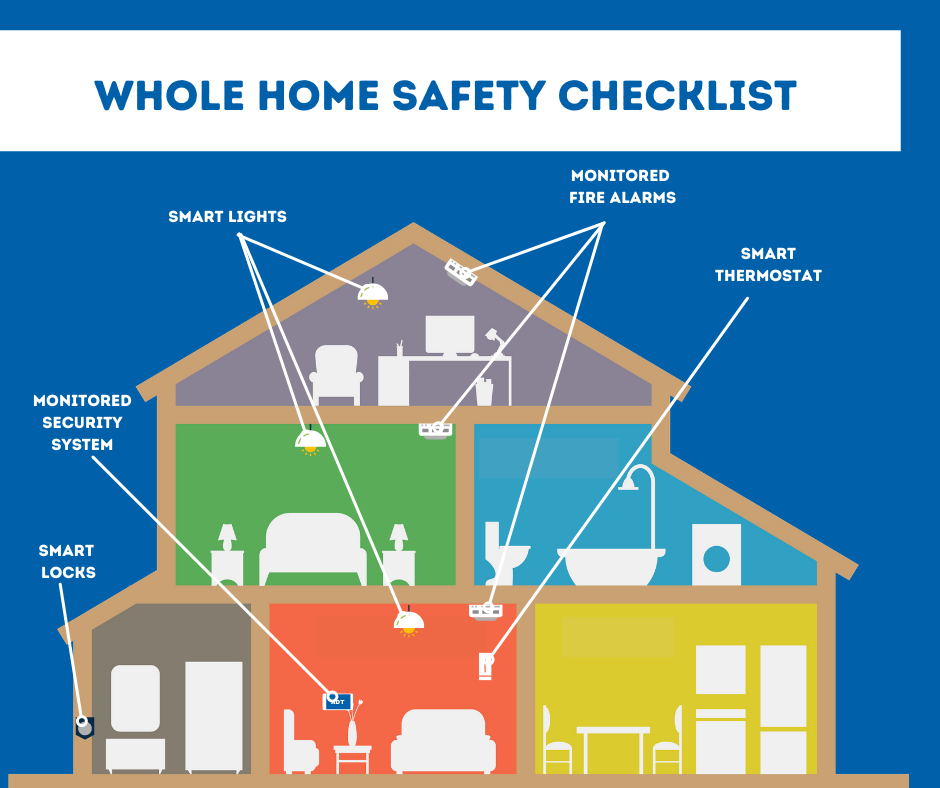
Basic Home Safety Checklist for Washington, DC
While you will want to take a individual room process for home safety, there are a few things that work for the entire house approach. These items can talk together through a wireless hub, and often can respond to one another. You might also control each of your home safety equipment with a mobile security app, like ADT Control:
-
Monitored Home Security System: All your entryways should use a sensor that warns you and your family to a break-in. As an alarm trips, your monitoring team picks up the alert and quickly contacts the police or fire department.
-
Smart Bulbs For Every Major Room: Of course, you can program your smart lights to become more eco-conscience. But smart lights can also help you remain safe throughout an emergency. Make your smart bulbs flash on when an alarm triggers to shoo off intruders or illuminate a path to a secure location.
-
Smart Thermostat: Like your smart lights, a smart thermostat in Washington, DC can save you up to 15% in energy spending. Also, it can start an exhaust fan during a fire.
-
Monitored Fire Alarms: At the very least, you will have a smoke detector on every floor. You can improve your fire readiness by hanging a monitored fire alarm that senses excessive heat and smoke, and notifies your 24-hour monitoring team when it detects a fire.
-
Smart Door Locks: Every door that needs a keyed lock can upgrade to a smart door lock. Now you may preset codes to each family member and receive notifications to your smartphone when they are activated. Your doors can even automatically unlock, helping you to quickly leave if you have a fire or dangerous situation.
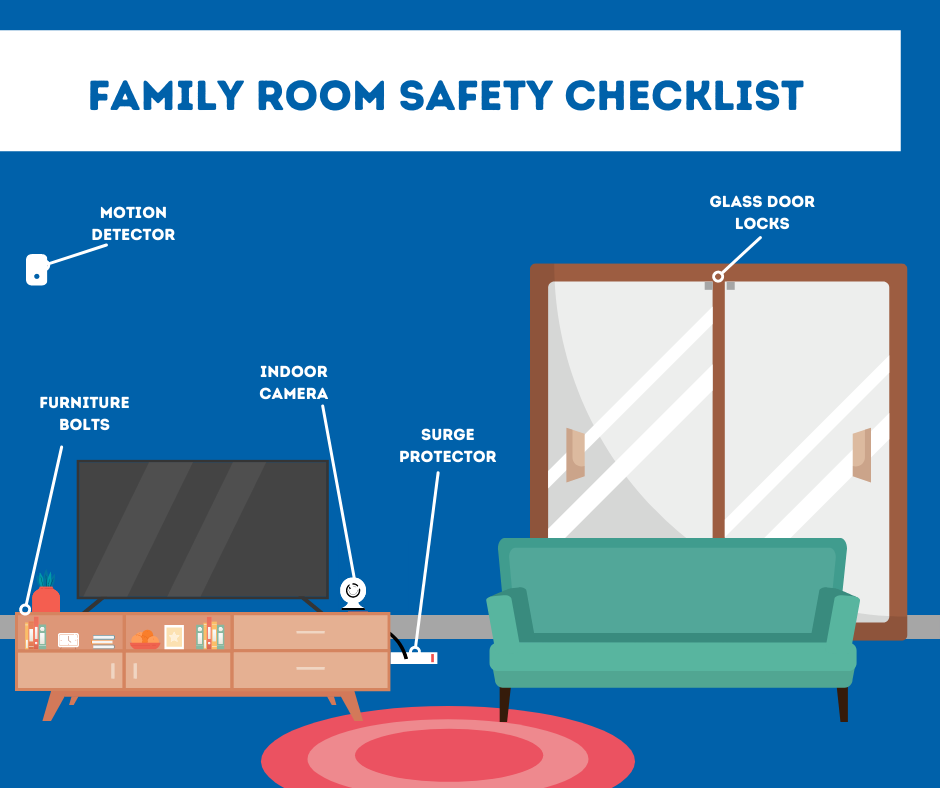
Family Room/Living Room Safety Checklist For Washington, DC
You’ll spend most of your time in the living room, so it can be the perfect area to improve your home safety. Electronics, like a TV or video games, typically reside in your family room, making it a popular room for thieves. Start with placing a motion sensor or indoor camera in there, then continue on with all these safety protocols:
-
Motion Detectors: By hanging motion sensors, you’ll get a shrieking siren if they detect unexpected motion in your family room. The best devices are motion detectors that aren’t set off by a dog or cat or you’ll see an alert every time your pet comes in for a bite of food.
-
Indoor Camera: An indoor security camera puts a visual on your family room. Get live feeds of the area so you can see what’s going on through the mobile app. Or chat with family members when they arrive home from school with the two-way talk feature.
-
Surge Protector/Cord Maintenance: Safeguard those electronics and stop overloading your circuits with a surge protector. For additional energy-efficiency, set up a smart plug with anti-surge functionality built-in.
-
Heavy Furniture Attached To The Wall: If you have babies or toddlers, you’ll want to attach your entertainment center or other heavy furniture to a wall. This is especially crucial if your living room has carpet that can make heavy objects extra unstable.
-
Enhanced Locks For Sliding Glass Doors: If your family room uses a sliding glass door that slides out to a backyard, deck, or porch, you get that the lock is pretty worthless. Use a special lock, like a cross bar or locks that secures the door to the bottom and top of the opening.
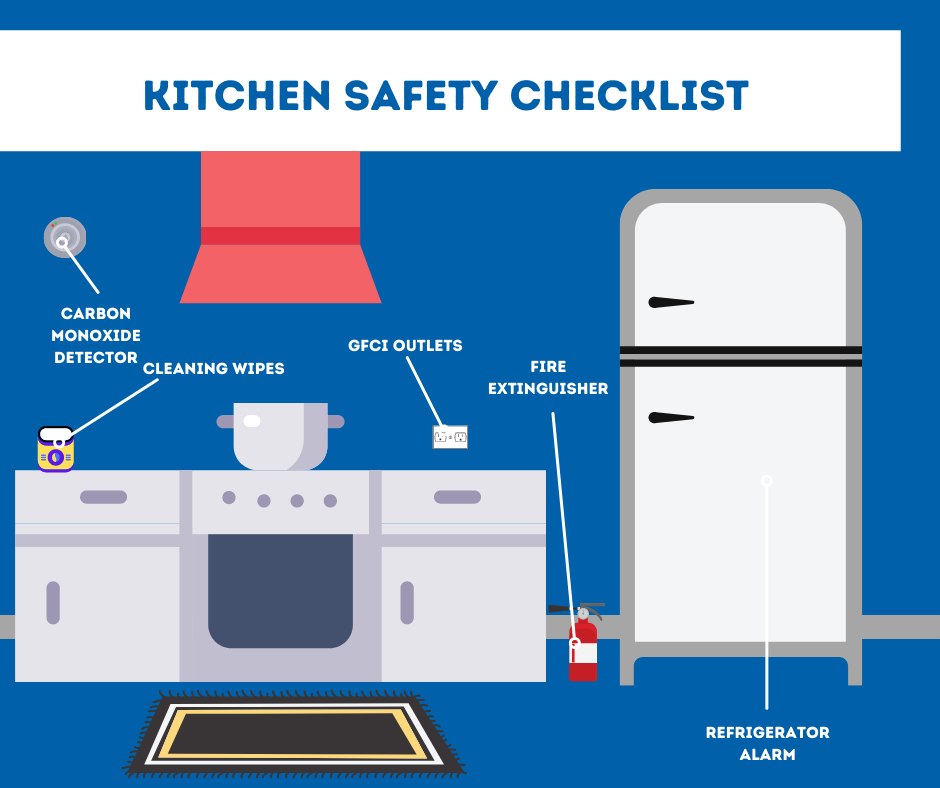
Kitchen Safety Checklist For Washington, DC
Your kitchen has room for items that should provide comfort and safety to your house. Many of these things should be easy to add and can be bought from the a retail store:
-
Fire Extinguisher: A fire can happen from an overfilled pot or a faulty burner. Always have a fire extinguisher at hand for any stove or oven emergencies.
-
Circuit Interrupter Box On Every Outlet: A circuit interrupter outlet should be used everywhere they’re by water to prevent an electric shock. That includes the outlets by your kitchen counter and sink. For 30 years, it’s been standard to have one circuit interrupter outlet per circuit. But for simplicity’s sake, you’ll want to install an unchained GFCI for every outlet.
-
Monitored CO Detector: A carbon monoxide detector is recommended for the kitchen if you use a gas stove and oven. If your gas burners malfunction, the CO detector will cause a high-decibel sound and contact your monitoring professional.
-
Disinfectant Wipes Or Spray: The largest safety hazard in the kitchen is the viruses, bacteria, and contamination from uncooked meat and dairy. Always store cleaning wipes or spray to scrub off your area when making a meal.
-
Refrigerator/Freezer Alarm: The items in the fridge need to remain at a cold temperature to stay safe to use. If you leave the fridge or freezer door open, then a small beep will tell you to check the seal. Some fridges already have this installed, older models don’t, and you’ll have to buy a refrigerator alarm from the store.
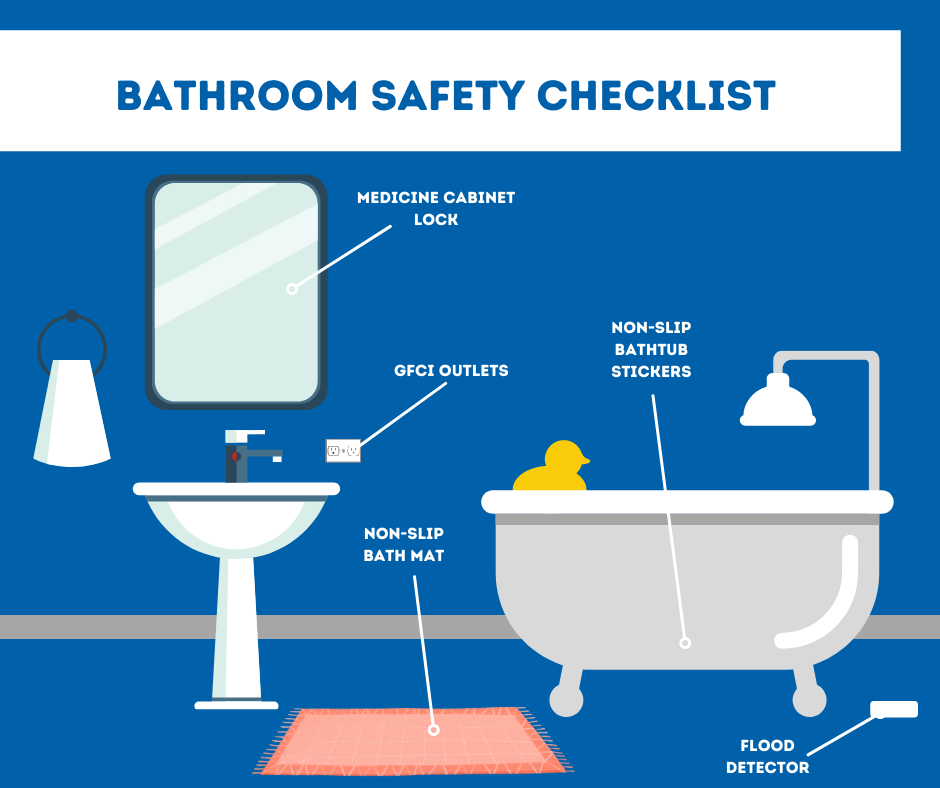
Bathroom Safety Checklist For Washington, DC
Just because there’s not a lot of space in your bathroom there’s still safety hazards. From water problems to anti-surge outlets, here are five safety improvements for your bathroom:
-
Flood Detectors: A leaking sink or tub can create a whole lot of water damage. Find pooling water early with a flood detector and save hundreds to thousands of dollars from water damage.
-
Textured Bath Mats: A slip and fall in the bathroom can be painful, causing cuts, sore joints, or broken bones. Make sure you steer clear from these problems with a non-slip bath mat for while you towel off.
-
Non-slip Bathtub Strips: Another water hazard, a tub basin can be a slippery surface to move in. It’s a good idea that every bathtub has some no-slip stickers so your feet and toes have a bumpy patch for stability.
-
Medicine Door Latch: If you have curious children or someone with memory complications, you need to take extra care regarding prescribed medicine. Secure your bottles by installing a medicine cabinet with a locking latch.
-
GFCI Circuits: Just like the kitchen, you need to also use a grounded circuit interrupter outlet on every bathroom outlet. This will cut the current if they ever get wet or there’s an unusual jolt from an electric razor or hair dryer.
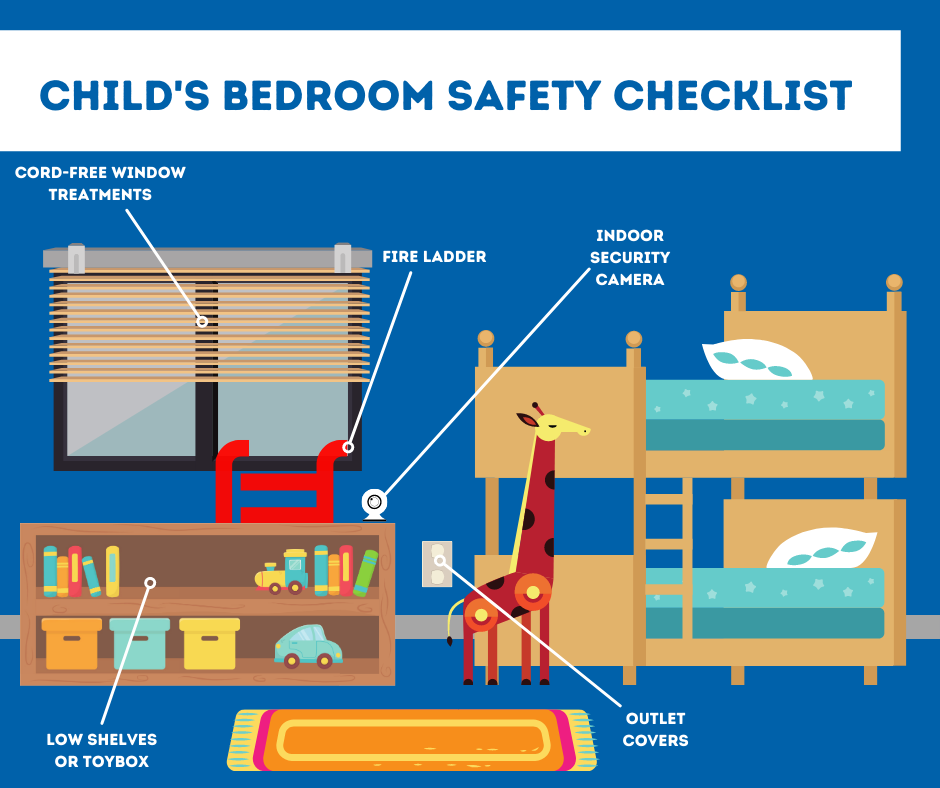
Kid’s Bedroom Safety Checklist For Washington, DC
Your child’s bedroom should balance safety with accessibility. If their window treatments or other items are safe but tricky to operate, then your children may try unsafe methods -- like climb a chest of drawers -- to touch them. Here are some easy, yet safe, ideas:
-
Cordless Window Treatments: Safety agencies have designated window treatment cords a secret hazard for kids and pets. Put in motorized treatments that your child can easily control through a remote. Or go state-of-the-art and pair your shades to your ADT smart hub so they rise without anyone’s help when it’s time to get up, and lower at night for added darkness.
-
Indoor Security Camera: A camera sitting on your child’s dresser can double as a high tech baby monitor that you can watch from your phone. And if they need something, they can hit the 2-way talk button on the camera.
-
Outlet Covers: While each outlet should have protective covers on them to protect your young children, this is especially important in a child’s bedroom. It’s the one room in your house where your toddler will most likely hang out by themselves without adult supervision.
-
Window Fire Ladder: If you use bedrooms on above the first floor, then you will want to install a window fire ladder. These will let a young one escape in case the stairs or ground floor are blocked off with fire. Remember to go over how to employ them a few times a year.
-
Toy Box Or Low Bookshelves: It’s interesting to think about a toy chest as a safety component, but you’ll see the light if you’ve ever stepped on a building block in your socked feet. A uncluttered floor means a quick way out if there’s a safety or security event.
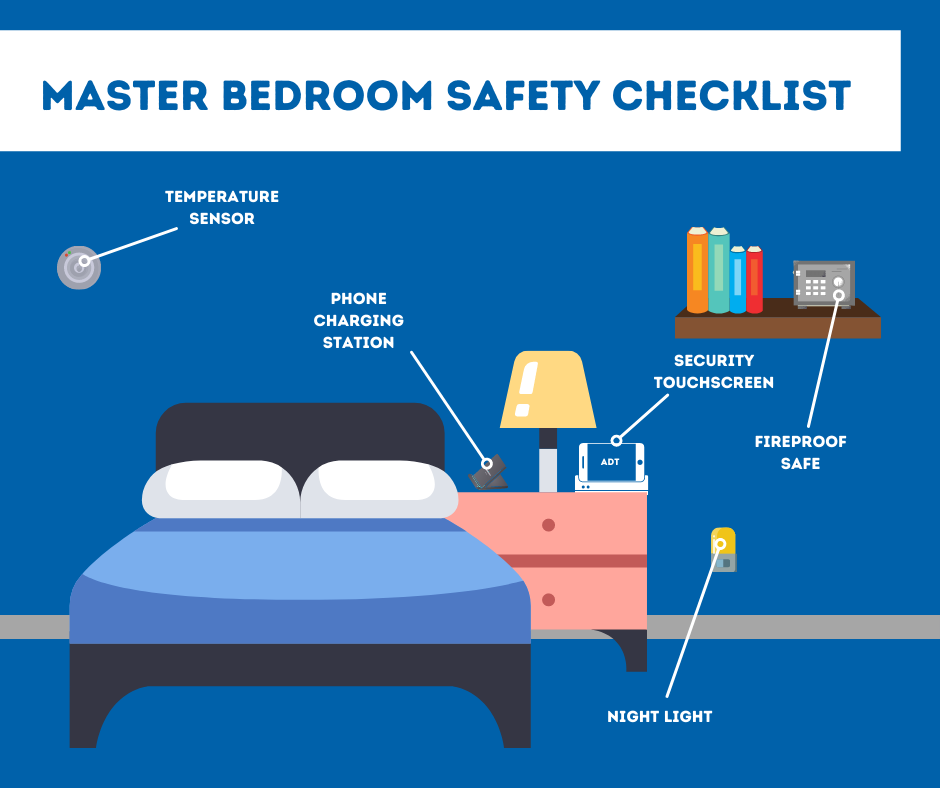
Main Bedroom Safety Checklist For Washington, DC
Your main bedroom should be your calm space, so let your safety devices make you more responsive if you have an emergency. After all, being wrenched awake by a loud alarm can be quite a shock.
-
Smart Hub Touchscreen: Having a smart hub on your dresser gives you a sense of what’s what that noise was without jumping out of bed. You could also use your ADT mobile app but, the touchscreen can be easier to use to use when you’re bleary-eyed and confused.
-
Device Charging Area: We depend on our phones for so many things now alarm clocks, internet searches, game machines, and sometimes even phones. The only problem is that a dead phone in the middle of the night cuts us off from reaching help if something goes wrong. To make sure your phone always works, a charging station or cord is an essential.
-
Smart Lights Or Nightlights: A small light helps ground you when you’re jolted awake from a siren or other loud sounds. If you can’t fall asleep with a small nightlight, install smart lights in your bedroom and hall. Then you can get light anytime with a mobile device or vocal command.
-
Fireproof Safe: Store your essential documents like insurance cards, stock certificates, or a bankbook in a fireproof safe. Your safe can be a big one that camps out in your closet or a smaller handheld safe that you can carry when you leave during an emergency event.
-
Heat Sensor: The problem with a master bedroom is that they can be too warm or be frigid since they are far away from the thermostat. A temperature sensor can communicate to your smart thermostat so you should have a pleasant, peaceful sleep at the perfect climate.
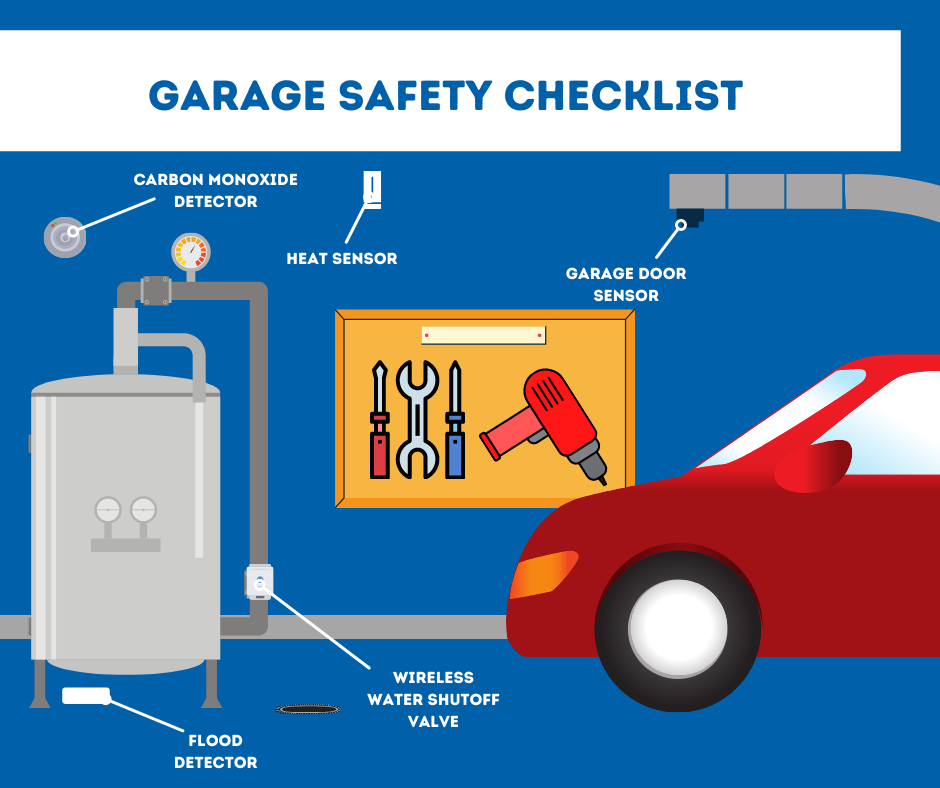
Basement/Garage Safety Checklist For Washington, DC
Most safety issues in the garage or basement deal with your water or heating system. Discovering issues at the source can stop larger problems later on. So, as you take a look around your garage or basement, check over these critical items:
-
Water Detector Or Sump Pump Alarm: Putting a flood alarm in back of your water heater and sump pump drain can save you from wading into a pond when you step into your garage or basement. The last you need is to lose the weekend getting rid of standing water and going through all those ruined boxes.
-
CO Alarm: It’s beneficial to hang a carbon monoxide alarm in a place where a natural gas leak can occur. If you have gas heat, you should install a detector in the same place as your HVAC unit.
-
Remote Water Shutoff Valve: If your flood sensor finds a hot water leak or a busted pipe, then you will have to shut off the primary water line quickly. With a wireless shutoff valve, you can block water flow from anywhere in the world. That’s perfect when you’re visiting relatives and see an emergency leak text on your mobile device.
-
Garage Door Sensor: Leaving the garage door open causes all types of issues. You can lose HVAC energy through that gaping hole, and critters or lurkers can just saunder in. A sensor will text you about a forgotten garage door and lets you close it remotely.
-
Heat Sensor: A heat sensor in your basement or garage is handy if you worry about your pipes freezing. The temperature in these areas can be drastically different than your main rooms of the home, so you will need to keep a closer eye on the temperature by using the ADT mobile app.
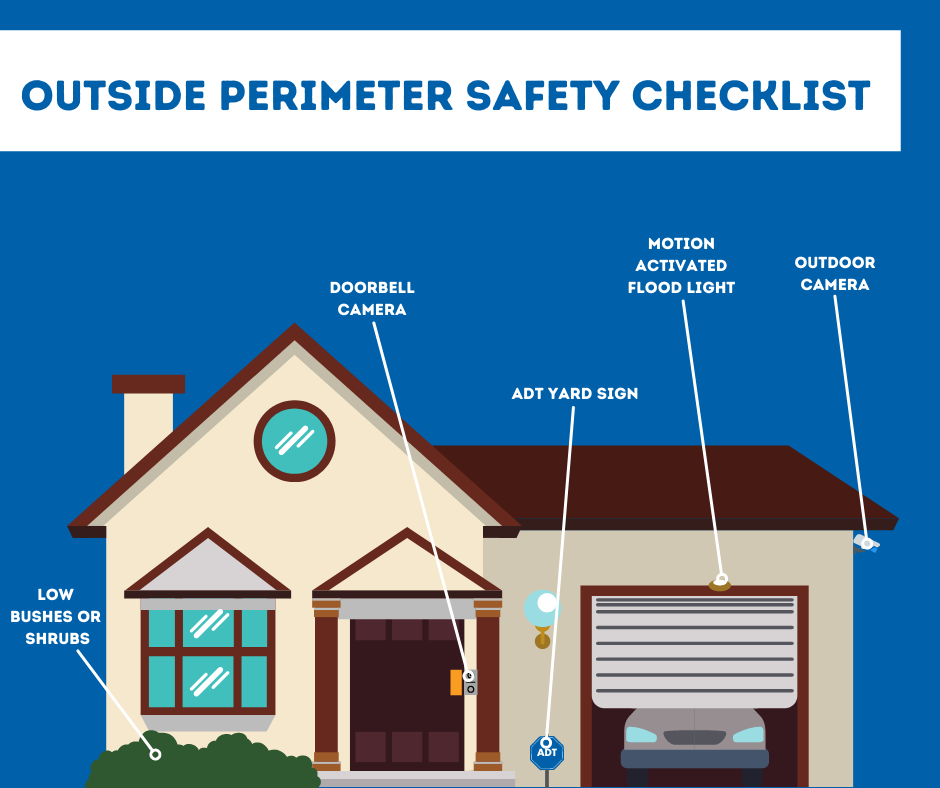
Home Perimeter Safety Checklist for Washington, DC
Your front yard, drive, and front step are just as crucial to defend as the interior of your house. Try the items on this checklist to defend your perimeter:
-
Doorbell Security Camera: See who’s knocking on the front door before you answer it and chat with visitors. View package deliveries and record video clips if they are stolen.
-
Outdoor Security Camera: You can hang outdoor cameras to notify you about suspicious movement in your back yard. These devices are nice in places where you might not have a window installed -- like around a cellar or by the driveway.
-
Low Shrubs: High shrubs can offer some privacy, but they also block you seeing into the outside. Don’t give potential intruders a place to hide. Plus, large bushes or trees too close to your home can jam up gutters and invite ants and termites.
-
ADT Signage: One of the largest discouragements for a thief is advertising to would-be rogues that you own a state-of-the-art ADT security system. An ADT sign by the stoop and a window cling will alert lurkers that they should keep walking to an unprotected target.
-
Motion Activated Flood Lighting: Light is the best enemy to those who skulk in the shadows. Motion-activated lights on your deck, patio, or garage can shoo possible intruders away. They also help you get inside when you come home late at night.
Contact Secure24 Alarm Systems To Help You With Your Home Safety Checklist for Washington, DC
While Secure24 Alarm Systems can’t help you with non-security devices on your Washington, DC home safety checklist, we can bring you a customized home security. With alarms, security cameras, and home automation, we can personalize the perfect system for your family’s needs. Simply contact (202) 221-4066 and talk to a professional or complete the form below. Or customize your own solution with our Security System Designer.
